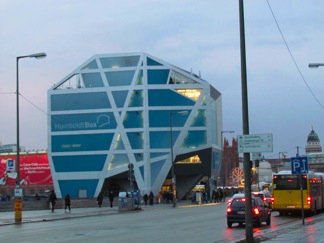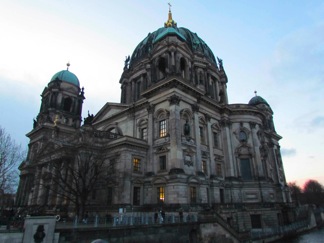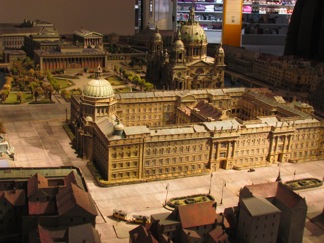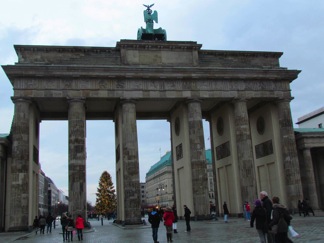
The Humboldt Box – Berlin
By Doreen Kerby
There is a blue building in the centre of Berlin with a futuristic architectural design. It really looks out of place on Museum Island, where all the buildings are elegant and have stood the test of time.

But the name Humboldt Box intrigued me. Having grown up in Humboldt, Saskatchewan, I knew a lot about the von Humboldt brothers and their fantastic contributions to education and geography. So I had to find out why this funny looking building existed on Schlosplatz (Palace Square).

The answer was simple. The Humboldt Box is a temporary structure that will be dismantled when the Berlin Palace and Humboldt Forum is completed in 2019. This five-storey building has three floors dedicated to displays for the rebuilding of Berlin Palace and the creation of the Humboldt Forum. The fourth floor is used for functions and the fifth floor is a charming restaurant with an observation platform that provides fabulous views of the centre of Berlin and the remains of the foundation where the palace once stood. When completed, Berlin will have a new showplace that will bring visitors by the thousands and the city will become one of the greatest museum cities anywhere in the world.

Recreating the palace is a very expensive undertaking but it has already commenced. In the Humboldt Box there is a vending machine that doesn’t sell anything but it will take your donation and print a receipt for the taxman!
The name says it all: The Humboldt Forum is named after the famous German brothers, Alexander and Wilhelm von Humboldt who early in the 19th century were researching foreign cultures and making great contributions to education. Five museums have been built on a small island in Berlin’s Spree River between 1824 and 1930. Museum Island was awarded UNESCO World Heritage Status in 1999 with a collection of art that spans six thousand years of human artistic endeavour. With the completion of the Humboldt Forum, there will be a center for the art and culture of Asia, America, Africa, Australia, Central America and the tropical Pacific Ocean.
The original Schloss or Berlin Castle was founded in 1443 and dominated the center of Berlin and the streets that led to it. It was the principal residence of the Hohenzollern Kings of Prussia and the German Emperors from 1701 to 1918. After the fall of the German Empire in 1918 it became a museum. It was King Friedrich Wilhelm II who reigned from 1786 to 1797 who disliked the view from his residence on Unter den Linden (Under the Lime Trees) because it lacked a gateway. Thus the Brandenburger Tor (Brandenburg Gate) was built, modeled after the Greek Gateway. During WWII it was badly damaged. During the Cold War it separated East and West and was left in a desolate state. But when the Berlin Wall fell in 1961 it became the symbol of a reunified Berlin and has been completely restored to its 19th century grandeur. It has become the most important symbol of reunified Berlin.

On February 3rd, 1945, one of the heaviest Allied air raids dropped incendiary and demolition bombs on Berlin, destroying the Berliner Schloss (Berlin Palace). It burned for almost four days and no efforts were made to extinguish the fire. After two years of daily air raids, Berliners had resigned themselves to let things burn. Though destroyed inside, the Schloss remained solid and firm in its foundations.
On September 7th, 1950 the building was cordoned off, supposedly due to its hazardous condition. The 500-year history of the Schloss was coming to an end. It was argued that it could be torn down for 8 million but reconstruction would cost 32 million. It took six months to complete the task.
On July 4th, 2002, the Deutsche Bundestag (German Parliament) voted for a rebuilding of the Castle. Work has already begun with a completion date set for 2015. It will be a powerful symbol of rebirth and reconciliation for all Europe. It was badly damaged in Hitler’s war and dynamited by Stalinist East German Communists. For 45 years a divided Berlin stood witness to the deep gash through the heart of Europe caused by Nazi and Stalinist dictatorship. Now for the first time in German history, Berlin is on a path to creating a “cultural world miracle” for the whole world to enjoy.